“Don’t panic, it’s organic” is the catchphrase of Tanshikar Spice Farm. The Tanshikar Spice Farm is a 25-acre working organic spice farm in South Goa. The farm is about an hour and a half’s drive from Agonda Beaches up into the hills on a winding road, through lush green rainforests of the Western Ghats and past the beautiful Netravali waterfall. It is the perfect way to spend an afternoon in the hills learning about spices.
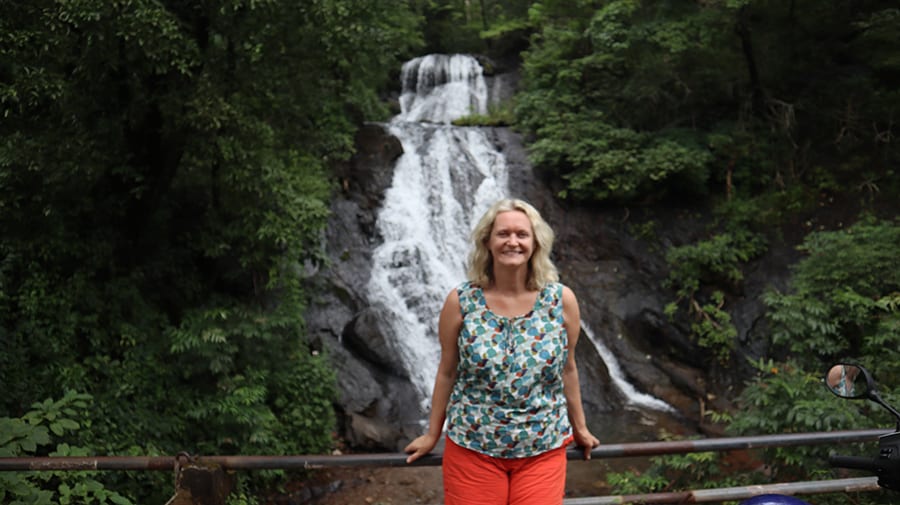
What you can expect in this post:
*This site uses affiliate links and I may earn a small commission when you use my links and make a purchase without incurring an additional fee yourself.
Thank you for supporting this website. See my disclaimer page for more details.
Tanshikar Spice Farm
The farm has been in the family for six generations and is full of spices, coconuts and other fruits, mushrooms and honey.
Gauri, our personal tour guide around the Spice Farm is the fifth generation of her family to live and farm here, and her children are the sixth.
The farm has been many years in the making. It started out as rice fields which her great-great-grandparents harvested. Her great-grandparents then introduced coconut trees and her grandparents planted spice trees in between them and the rest, as they say, is history.

The whole family still lives in the 200-year-old traditional house built from mud with floors finished in hardened cow dung. Yes, you read that correct, cow dung. Not only does it harden to a tough finish, but it is also flexible and makes an ideal surface for a busy house.
The farm has over 40 acres of land, of which 25 are specifically used for growing over 14 different varieties of spice and fruit trees. Everything is organic and they encourage beneficial insects to help tackle bacterias that could damage the plants.
The bees they keep not just for their honey, but for their help in pollination of the plants and the honey is a welcome by-product.

YOU MIGHT ALSO LIKE: The Taj Mahal – to tips for your visit
The Guided Tour around the Spice Farm
We joined with two other couples to tour the spice farm, led by Gauri. As we walked around, she explained about each of the different spices. We were told about the king of spices, black pepper and cardamom, the queen, the potentially lethal properties of nutmeg and the way to pollinate vanilla.
Gauri’s intimate knowledge of the spices and how they are grown interwoven with the history of her family and the farm made the time fly by.
When we arrived back at the reception, we were each given a gift of a selection of spices and invited to go through to have our lunch.
The Restaurant

Included in the cost of your ticket is a meal at the Tanshikar restaurant. The vegetarian dishes are served in a buffet style and you help yourself from the clay pots. Our selection included rice, chapati, daal, bean curry, a cabbage salad, potato patties and a lovely spicy lime pickle, all freshly prepared with spices from the farm.
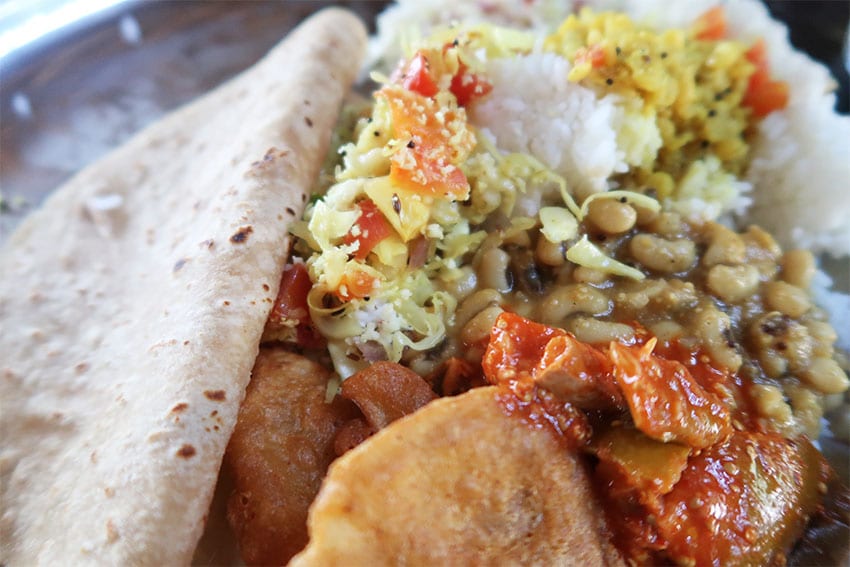
Staying at the Farm
You can experience the peace and quiet of the farm by staying in the Ecological Rest House which is set amongst the trees and flowers. Like the main farm building the villas are made from mud. The mud has good thermic qualities, keeping them cool in the summer and warm in the winter.
The accommodation also includes old Indian-style cottages and Tree House.
Visiting Tanshikar Spice Farm
Address: The Tanshikar Spice Farm, Netravali, near Smriti Yoga, Sanguem, Goa 403704, India
Opening hours: The farm is open from 9:00 am to 5:00 pm seven days a week.
Tours: Book tours to Tanshikar Spice Farm on Tripadvisor
The Spices and Fruits at Tanshikar Spice Farm
Vanilla

True vanilla, those lovely scented long black pods bursting full of tiny black seeds, start their life as a climber on other trees. A member of the orchid family, the flowers make it difficult for birds and insects to get to the pollen and on the farm, the workers use a toothpick to individually pollinate each flower. This is one of the reasons that vanilla is so expensive.
From these flowers, only one pod grows which takes 9 months to mature. After harvesting, the pods are cured for around another 3 months and then they are ready for use.
Cardamom
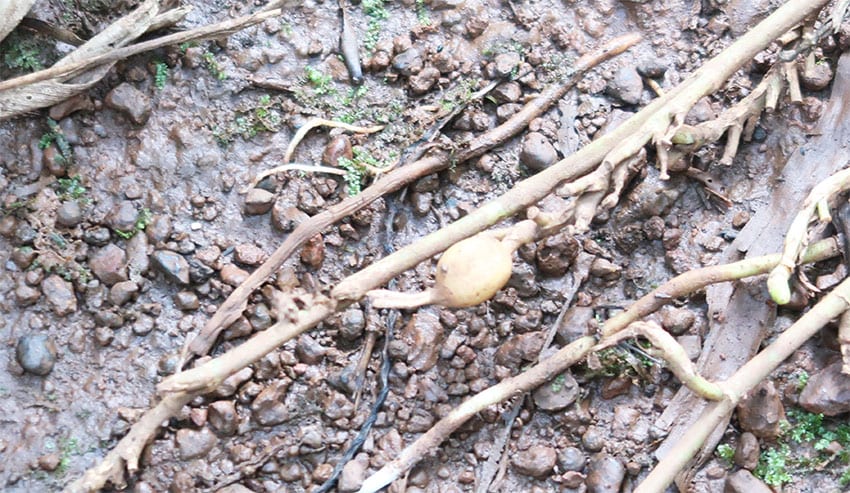
The Queen of Spices, cardamom is a member of the ginger family. The prized capsules of cardamon pods grow on shoots from the roots of the plant along the ground.
This wonderful sweet green pod is used in traditional Indian cuisine and is one of the ingredients of garam masala but is also used to flavour desserts and the ubiquitous chai tea.
Green, Black and White Pepper
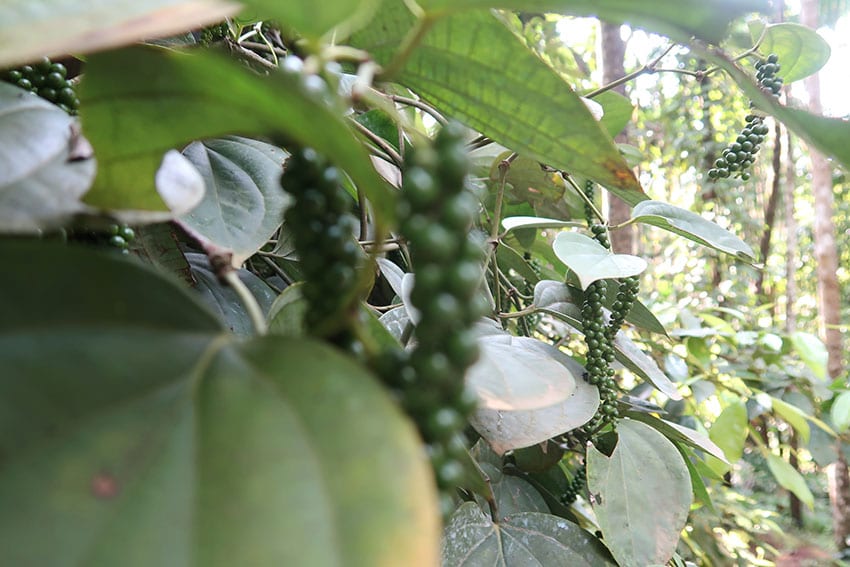
Do you know the difference between green, black and white pepper? Well, technically they are all the same but are just peppercorns at different stages.
The green peppercorns are the freshest of the peppers and are unripe black corns.
The black corns are the wonderful, hot, slightly orangey, peppercorns that flavour our food, and the milder white peppercorns are the seed of the fruit with the black skin removed.
Cinnamon
Cinnamon sticks are those long tubes of tightly packed aromatic bark and are taken from the inner bark of the cinnamon trees. Used in Indian cooking for flavouring both sweet and savoury dishes, cinnamon has a wonderful warming sweet taste and is one of the ingredients for garam masala.
Cloves
Cloves are actually the dried flower buds of the clove tree which are harvested while still immature and then dried. Used in cooking and spice mixes like garam masala, cloves have a pungent slightly sweet and bitter taste. It is also used in preparations for toothache.
Cacao
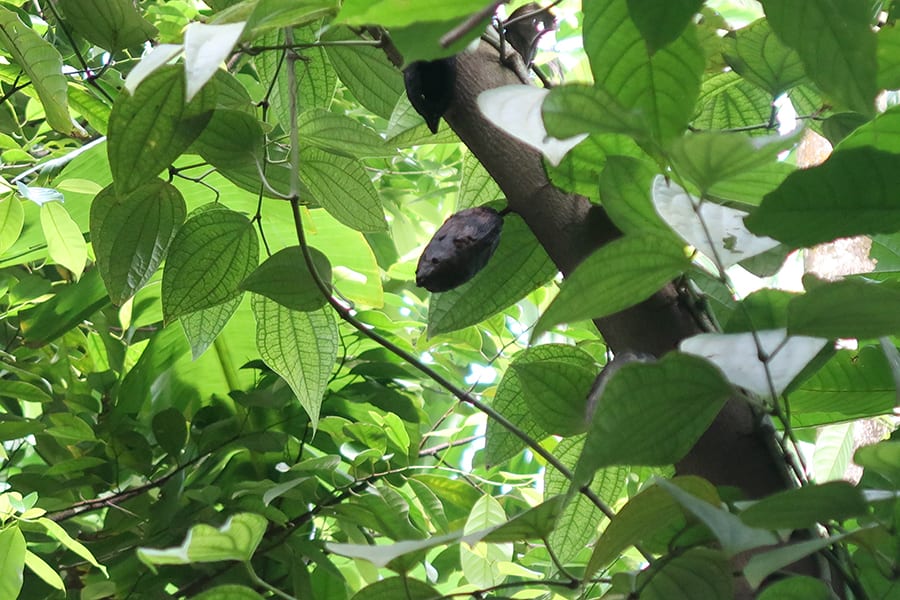
Cacao or cocoa are the basis for most chocolate. It starts life as a large pod on the cacao tree. When they are mature the pods are harvested and then split open to reveal 30-40 beans and surrounding pulp. The beans are then spread out to let them sweat the pulp off. The beans are then fermented and dried.
Turmeric
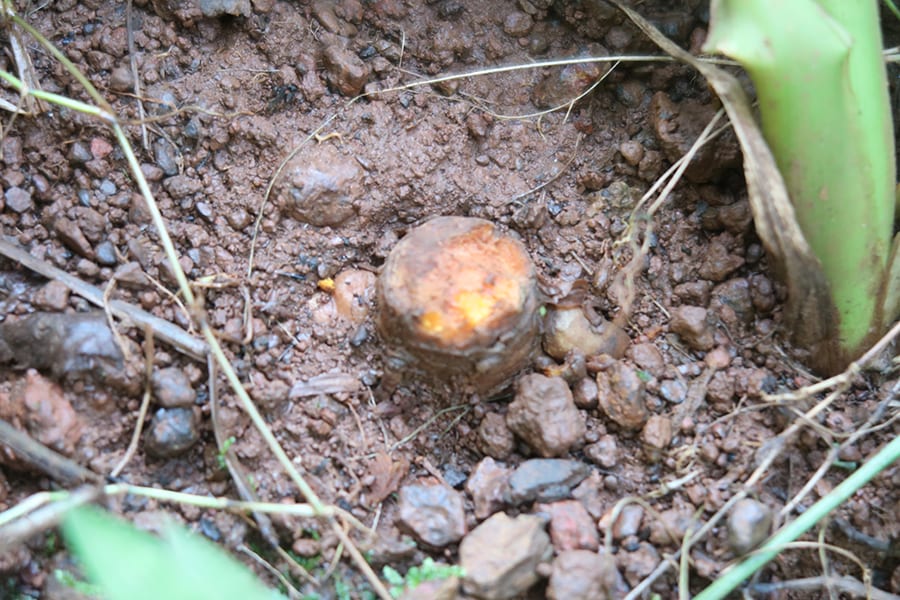
Turmeric, that wonderful yellow spice with a pungent earthy taste and jazzes up rice, spices up drinks and is alleged to be good for our health, starts like as a rhizome at the base of the turmeric plant. The rhizome is then they are used fresh or boiled and ground to reveal the yellow powder to be used in cooking or for dyeing.
Nutmeg & Mace
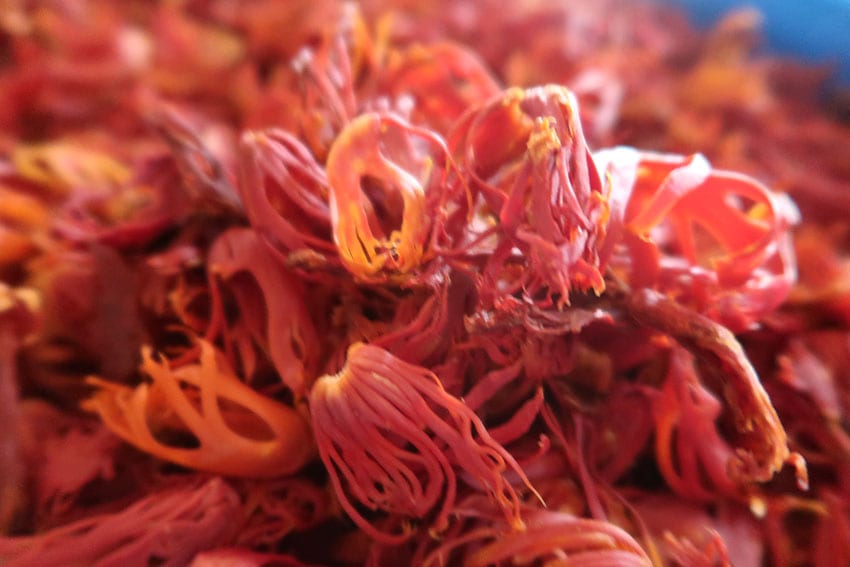
Nutmeg and mace are produced hand in hand; the mace is the lacy covering that protects the nutmeg nut inside.
Did you know the nutmeg tree can be one of three different sexes? 80% are female, 20% are male and a very rare few produce male one year and female the next. The trees don’t come to their sexual maturity for six to eight years, so when they are planted you don’t know what you are going to get, you just have to be patient.
Half a small nutmeg grated into warm milk at night will help you sleep, but be careful, three nutmegs can kill!
Other Produce

Tanshikar Spice Farm also produces chillies, coffee beans, betel nut, pineapples, bananas, cashew nuts and papaya; oyster mushrooms which are grown on compacted straw hung up on rope; honey from their bees in the hives around the farm.
If you are staying in the south of Goa I would recommend a visit to the Tanshikar Spice Farm for a relaxing and interesting trip.
Do you have a favourite spice? If you have any questions or wish to share any tips about spices, please comment below!
Don’t forget to pin this article so you can come back to it later

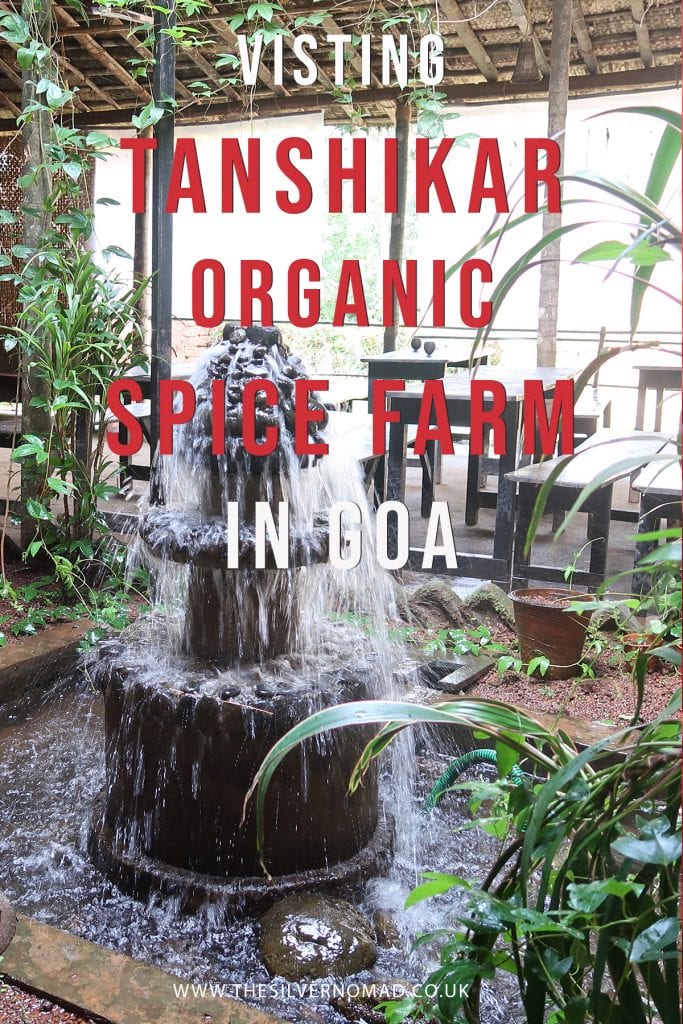
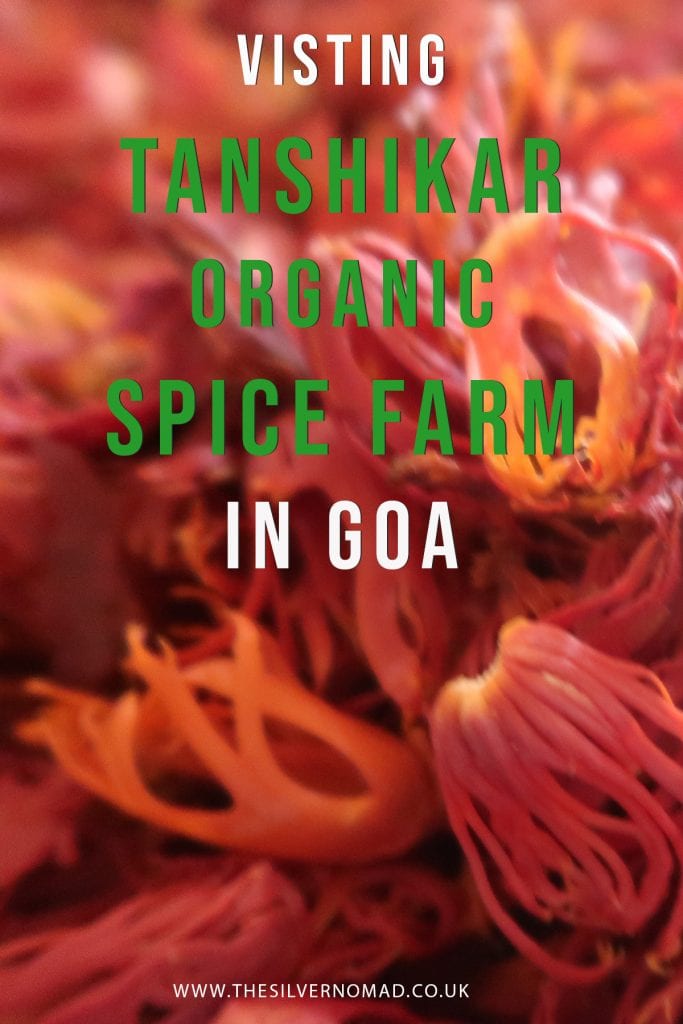

Hi there, I am travelling with my partner to Agonda for a few days from tomorrow. Just wondering how would we go about booking the spice tour? Cheers
Hi, we didn’t have to book, we just turned up. Hope you enjoy it Rakesh!
Oh this looks so lovely. I can’t believer I missed it during my stay in agonda. I was there 8 weeks and plan to head back again, saving this for future reference thank you
I wanted to have a break from the beach and see what a spice farm was like. I am sure you will enjoy it.
Looks like an interesting place to visit in Goa! Spice is the backbone to Indian cooking. The home stay also gives the opportunity to immerse in the local culture including local food. Enjoyed reading this blog post. 🙂
What an amazing place to visit! I love learning how spices grow and visiting farms and producers when I travel. Goa is high on my list and I really want to prioritize getting there once it’s safe to travel again!
Cate you will love Goa, such a blend of cultures and very beautiful. I can’t wait to go back too.